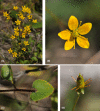Investigation of phylogenetic relationships within Saxifraga diversifolia complex (Saxifragaceae) based on restriction-site associated DNA sequence markers
- PMID: 37928197
- PMCID: PMC10620575
- DOI: 10.1002/ece3.10675
Investigation of phylogenetic relationships within Saxifraga diversifolia complex (Saxifragaceae) based on restriction-site associated DNA sequence markers
Abstract
Subsect. Hirculoideae Engl. & Irmsch., belonging to Saxifraga sect. Ciliatae Haw., has high species richness. It can be divided into S. diversifolia, S. pseudohirculus, and S. sinomontana complexes based on morphological characteristics. The species with prominent leaf veins on the posterior leaf edge were placed in the S. diversifolia complex, which is mainly distributed on the eastern and southern margins of the Qinghai-Tibetan Plateau. In this study, 53 samples, representing 15 of the 33 described species in the S. diversifolia complex, were sequenced using the Restriction-site Associated DNA Sequence (RAD-seq) technique. A total of 111,938 high-quality SNP loci were screened to investigate the phylogenetic relationships within the S. diversifolia complex. The result of the neighbor-joining (NJ) tree shows that the S. diversifolia complex is a paraphyletic group. Despite of some inconsistencies as revealed by genetic structural analysis, clustering results of representative species reconstructed by both NJ and principal component analysis analyses support previous biogeographic and morphological evidences. In addition, long-distance gene flow events for 11 taxa were detected in the S. diversifolia complex, respectively from S. implicans 1 to S. implicans 2, S. diversifolia and S. maxionggouensis, and from S. maxionggouensis to S. nigroglandulifera. These findings may improve our comprehension of the phylogeny, classification, and evolution of the S. diversifolia complex.
Keywords: RAD‐seq; S. diversifolia complex; SNP loci; Saxifraga; phylogeny.
© 2023 The Authors. Ecology and Evolution published by John Wiley & Sons Ltd.
Conflict of interest statement
None declared.
Figures





Similar articles
-
Chloroplast phylogenomics and the taxonomy of Saxifraga section Ciliatae (Saxifragaceae).Ecol Evol. 2023 Jan 6;13(1):e9694. doi: 10.1002/ece3.9694. eCollection 2023 Jan. Ecol Evol. 2023. PMID: 36620410 Free PMC article.
-
Evolutionary radiations in the species-rich mountain genus Saxifraga L.BMC Evol Biol. 2017 May 25;17(1):119. doi: 10.1186/s12862-017-0967-2. BMC Evol Biol. 2017. PMID: 28545386 Free PMC article.
-
Development of EST-SSR markers in Saxifraga sinomontana (Saxifragaceae) and cross-amplification in three related species.Appl Plant Sci. 2019 Jun 12;7(6):e11269. doi: 10.1002/aps3.11269. eCollection 2019 Jun. Appl Plant Sci. 2019. PMID: 31236316 Free PMC article.
-
Taxonomic resurrection of Saxifraga lancangensis (Saxifragaceae).Bot Stud. 2024 Apr 29;65(1):12. doi: 10.1186/s40529-024-00418-y. Bot Stud. 2024. PMID: 38679692 Free PMC article.
-
Rapid Intraspecific Diversification of the Alpine Species Saxifraga sinomontana (Saxifragaceae) in the Qinghai-Tibetan Plateau and Himalayas.Front Genet. 2018 Sep 18;9:381. doi: 10.3389/fgene.2018.00381. eCollection 2018. Front Genet. 2018. PMID: 30279701 Free PMC article.
Cited by
-
Genetic diversity, population structure, and phylogenetic relationships of a widespread East Asia herb, Cryptotaenia japonica Hassk. (Apiaceae) based on genomic SNP data generated by dd-RAD sequencing.Front Genet. 2024 Aug 14;15:1368760. doi: 10.3389/fgene.2024.1368760. eCollection 2024. Front Genet. 2024. PMID: 39205937 Free PMC article.
-
The complete plastome of Saxifraga giraldiana Engler and its phylogenetic analysis.Mitochondrial DNA B Resour. 2024 Aug 30;9(9):1157-1161. doi: 10.1080/23802359.2024.2397983. eCollection 2024. Mitochondrial DNA B Resour. 2024. PMID: 39234582 Free PMC article.
References
-
- Abbott, R. , Albach, D. , Ansell, S. , Arntzen, J. W. , Baird, S. J. , Bierne, N. , Boughman, J. , Brelsford, A. , Buerkle, C. A. , Buggs, R. , Butlin, R. K. , Dieckmann, U. , Eroukhmanoff, F. , Gril, A. , Cahan, S. H. , Hermansen, J. S. , Hewitt, G. , Hudson, A. G. , Jiggins, C. , … Zinner, D. (2013). Hybridization and speciation. Journal of Evolutionary Biology, 26(2), 229–246. 10.1111/j.1420-9101.2012.02599.x - DOI - PubMed
-
- Abbott, R. J. , & Comes, H. P. (2003). Evolution in the Arctic: A phylogeographic analysis of the circumarctic plant, Saxifraga oppositifolia (purple saxifrage). New Phytologist, 161(1), 211–224. 10.1046/j.1469-8137.2003.00953.x - DOI
-
- Ashley, M. V. (2010). Plant parentage, pollination, and dispersal: How DNA microsatellites have altered the landscape. Critical Reviews in Plant Sciences, 29, 148–161. 10.1080/07352689.2010.481167 - DOI
LinkOut - more resources
Full Text Sources

